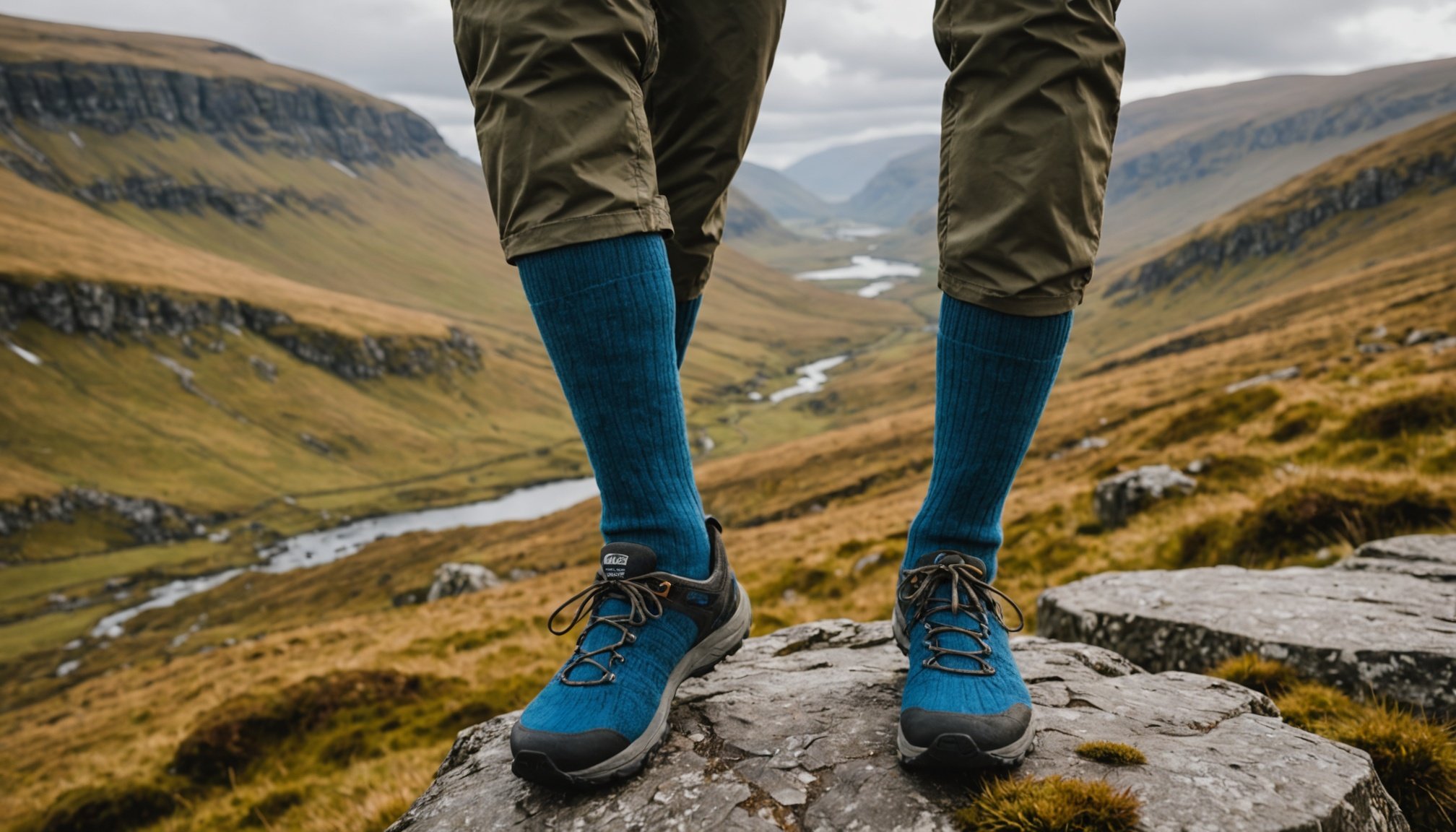Overview of Wool Hiking Socks
Selecting the right wool hiking socks is crucial for comfort and performance on the trails. Wool, particularly Merino wool, offers notable advantages over synthetic options. This natural material excels in moisture-wicking, drawing sweat away from the skin to keep feet dry. One of the key benefits of wool is its ability to regulate temperature, providing warmth in cold conditions and breathability in warmer climates.
When choosing hiking footwear, the sock plays a pivotal role. Wool’s cushioning and softness can significantly enhance comfort, reducing the risk of blisters and irritation during long treks. Compared to synthetic materials, wool naturally resists odours through its antibacterial properties, contributing to a fresher hiking experience.
In parallel : Ultimate Guide to Choosing Perfect Wool Gloves for a Cozy UK Winter
Making an informed choice about sock material can amplify your enjoyment and performance during hikes. Proper sock cushioning helps with shock absorption and can adapt to varied terrains, making it an essential component of hiking gear. Seamless construction further adds to comfort, as it prevents chafing and enhances fit. Understanding these factors ensures you select the best footwear combination for optimal hiking experiences.
Top Wool Hiking Socks for UK National Parks
Choosing the best wool hiking socks for adventures in UK National Parks involves considering both performance and preference. Some top brands that stand out include Smartwool, known for its moisture-wicking capabilities and Merino wool construction. These socks offer superb temperature regulation, making them ideal for the UK’s unpredictable weather. Another popular choice is Darn Tough, renowned for their durability and lifetime guarantee, ensuring hikers get great value for money.
Have you seen this : Discover Britain’s Finest: Stunning Evening Gowns Crafted from Recycled Materials by Visionary Designers
When selecting the best wool hiking socks, it’s essential to focus on key features like cushioning and fit. Cushioning not only enhances comfort but also aids in shock absorption on rocky terrains. This is crucial for long hikes in parks such as the Lake District where uneven paths are common. Fit, tailored by extensive sizing options available across brands, ensures a snug yet comfortable experience, preventing blisters and irritation.
To balance price and quality, consider socks from brands like Icebreaker, which offer solid performance at a reasonable price point. Always weigh up your budget against the long-term benefits of durability and comfort. Well-chosen hiking socks can significantly elevate your hiking experience, providing the necessary protection and comfort.
Material and Construction of Wool Hiking Socks
Choosing the right wool materials is vital for the durability and performance of hiking socks. Merino wool stands out due to its fine fibres, offering a soft texture while providing remarkable insulation and moisture management. It’s common to find Merino blended with synthetic fibres to enhance durability. This combination ensures maximum comfort and extends the lifespan of your socks.
Sock cushioning and thickness are critical factors. Thicker socks usually offer more cushioning, essential for reducing foot fatigue and discomfort on rocky trails. However, for warmer climates, a lighter cushioning might better suit to prevent overheating. The construction should be seamless to avoid chafing, enhancing the sock’s overall fit.
Seam placement and construction play a pivotal role in comfort. Poorly placed seams can irritate and cause blisters, whereas seamless construction adds to a snug fit, reducing friction during long hikes.
Understanding these aspects allows hikers to make informed decisions about their hiking footwear. Whether trekking through the rugged terrains of the Lake District or the varied landscapes of other UK national parks, selecting well-constructed wool hiking socks can significantly enhance both comfort and performance.
Fit and Sizing Considerations
Finding the perfect fit in wool hiking socks is crucial for hiking comfort. Too tight or too loose can lead to discomfort or injury. Here’s a quick guide on understanding sock sizing for optimal fit.
Understanding Sock Sizing
Different brands offer a variety of sizing options. Typically, they range from small to extra-large, often aligned with shoe sizes. Check each brand’s sizing chart before purchasing to ensure the best fit for your foot size. Precise sizing is essential to prevent shifting, which can cause blisters.
Common Fit Issues and Solutions
Fit issues often arise from incorrect sizing, leading to discomfort on the trail. A sock that is too large might bunch up, causing blisters. Conversely, a sock that’s too tight can restrict circulation, leading to cold feet.
Solutions include:
- Selecting the right size: Follow the specific brand’s size guide.
- Checking cushioning zones: Ensure they align well with foot contours.
- Opting for seamless designs: They provide a snug fit without irritation.
Considering these factors will improve comfort and enhance your overall hiking experience. Troubleshooting these fit issues ensures that your hiking stays enjoyable and safe.
Performance Features of Wool Hiking Socks
When exploring trails, moisture-wicking is crucial to keep feet dry. Wool, especially Merino wool, naturally excels in drawing perspiration off the skin, ensuring comfort despite active hiking. This feature prevents blisters and enhances the hiking experience by maintaining a dry interior environment. In addition, wool’s unique property efficiently manages moisture without the need for chemical treatments, setting it apart from synthetic options.
Insulation is another pivotal attribute of wool hiking socks. Natural fibres have an exceptional ability to regulate temperature, offering warmth in colder UK climates. Even when wet, wool retains thermal properties, keeping feet warm, which is particularly invaluable in the variable British weather. This quality ensures a balanced climate inside the sock, crucial for prolonged outdoor excursions.
Moreover, wool aids temperature regulation, adapting to changing conditions effectively. As the weather shifts, these socks provide snug warmth or ventilated cooling, depending on what nature throws your way. This flexibility allows hikers to embark on journeys without worrying about overheating or excessive cooling, allowing full focus on the trail ahead. Understanding these distinct performance features can empower hikers to make well-informed decisions.
Comparisons: Wool Hiking Socks vs. Other Materials
When considering sock material comparison, wool hiking socks offer distinct advantages over synthetic alternatives, boasting high performance in various hiking conditions. Wool is inherently moisture-wicking, efficiently drawing sweat away from your skin and keeping your feet dry. This reduces the risk of blisters, a common complaint among hikers. Synthetic materials like polyester can also wick moisture but often rely on chemical treatments to achieve similar effects, potentially leading to a less natural feel.
Insulation is another key area where wool excels. It provides excellent thermal regulation, offering warmth in cold weather while remaining breathable in the heat. Even when wet, wool maintains its insulating properties, whereas synthetic fibers typically lose warmth. This makes wool particularly suited for the variable conditions found in many UK hiking environments.
Conversely, synthetic socks can boast great durability and affordability. They resist wear and tear, often outlasting wool socks with regular use. However, for those prioritizing comfort, moisture management, and temperature adaptability, wool remains the preferred choice. Personal preferences and specific hiking conditions can ultimately guide the decision between wool and synthetic hiking socks, ensuring an optimal hiking experience.
Care and Maintenance of Wool Hiking Socks
Proper sock maintenance is essential to maintain the quality and longevity of your wool hiking socks. Wool, being a natural fibre, requires special care in comparison to synthetic materials. Start with washing them inside out to protect the fabric from abrasion. Always use a gentle wool detergent and cold or lukewarm water, as hot water can cause wool to shrink. Preferably, hand washing is recommended although some socks can handle a delicate machine wash cycle.
When it comes to drying, avoid wringing them out harshly. Instead, gently squeeze out excess water and lay them flat on a towel. Rolling them in a towel can also expedite drying while maintaining their shape. Never tumble dry or place them directly on a radiator, as direct heat can cause fibre damage.
Tips for extending their life include rotating socks rather than wearing the same pair day-to-day, and promptly addressing any small holes or tears by mending them to prevent further damage. Inspecting your socks regularly will help determine when it’s time for a replacement. Once cushioning or elasticity is compromised, it’s best to invest in new pairs for continued comfort and performance.
Recommendations for Specific Environments
Choosing the right wool hiking socks for specific environments can significantly elevate your hiking experience. The UK National Parks present diverse conditions that demand socks tailored for weather variations and terrains. Wool excels in wet and humid settings due to its moisture-wicking capabilities. When hiking in such conditions, select Merino wool socks, renowned for keeping feet dry and limiting blisters even in persistent dampness.
Cold-weather hiking, frequent in UK highlands and moors, requires socks with superior insulation. Thickly cushioned wool socks maintain warmth even when temperatures plummet or if they become moist. This insulation ensures consistent thermal regulation, essential for maintaining comfort on frosty trails.
For varied terrain, such as rocky paths in the Lake District, consider socks offering significant cushioning and durability. These features not only enhance comfort but also augment footwear performance. Wool blended with synthetic fibres often provides added resilience against wear and tear, supporting extended treks across challenging landscapes.
Environment-specific recommendations ensure hikers remain comfortable and protected, mitigating the impact of unpredictable weather and diverse terrains. Prioritising these factors will empower you to explore UK national parks with confidence and ease.


